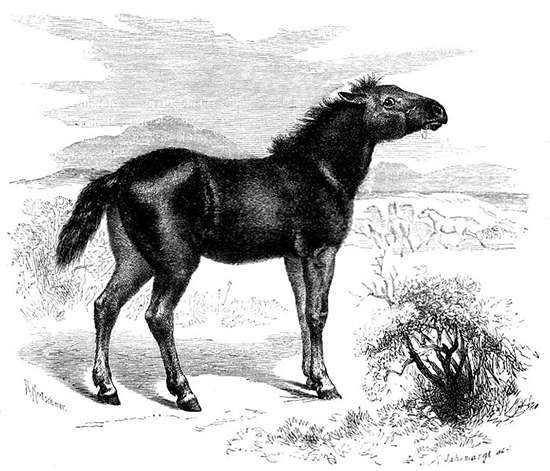Along with the Heck cattle and Scottish Highlanders, another reconstructed species roams the Dutch dunes.
The sturdy Konik horse, also known as the Polish primitive, is the result of an attempt to 'breed back' the tarpan, an extinct subspecies of wild horse. A forest-dwelling horse with a distinctive silver-gray coat, tarpans once roamed Western Europe through Russia. The endangered Przewalski's horse is the only surviving subspecies of the wild horse, Equus ferus, found only in zoos and in wild herds that have been reintroduced to places like Mongolia and Chernobyl.
The last wild tarpans were extirpated between the 1820s and 1890s, while the last captive tarpans died out somewhere between 1910 and 1920. Sources are unclear whether the final herds were true tarpans, tarpan mixes, or domestic horses that happened to look a lot like their wild relatives.
It may be extinct, but the tarpan still clings to existence via cultural memory and scattered genes. The fact that many "primitive" breeds of domestic horse still graze the world's meadows has tempted hopeful breeders to resurrect the tarpan on at least three occasions.
The Polish Konik is the oldest of the existing pseudo-tarpans, originating at least to the 1800s if not far earlier. In 1936, these groups of small, tarpan-like horses caught the attention of Tadeusz Vetulani, a professor at Poznan University. He gathered up the most suitable candidates to concentrate their primitive characteristics in an attempt to breed-back the tarpan.
Around the same time period, the Heck brothers, of Heck cattle fame, mixed up their own version of a tarpan from koniks, Icelandic ponies, and Przewalski's horses. The Hegardt horse may be the most fanciful of all the modern tarpans. In the 1950s, Harry Hegardt gathered up American mustangs with tarpan-like characteristics to create his own stable of Equus ferus ferus - never mind that mustangs are descended from Spanish riding horses that had been domesticated for centuries.
Confounding these attempts is the fact that no one particularly knows what the tarpan looked like. The subspecies was gray, with a dorsal stripe and zebra barring on the legs, but breeders seem to disagree on other basics. Did it have a floppy or an erect mane? Did it turn white in the winter? There is a single photograph and a single life drawing to document the subspecies's appearance.
The Moscow Zoo's stallion (pictured above) likely had domestic horse blood in it, while Borisov's engraving was of a juvenile. Cave paintings, those old standbys, are not much more help. Almost all prehistoric paintings held up as evidence of the tarpan either have a generic appearance, or more closely resemble the Przewalski's horse.
The confusion has lead to an interesting oversight. The Sorraia horse, a rare breed found in isolated regions of Portugal, is so closely related to the tarpan it may actually be one. While there is disagreement and ungoing genetic analysis, some scientists suspect that the Sorraia may be a regional variation or relic of Equus ferus ferus. In other words, the tarpan may be slightly less extinct than suspected.
Call it a Konik, Heck or Hegardt, the modern tarpan is still, fundamentally, a fake. Like a plastic flower or concrete rock, it matches its inspiration on the outside, but remains a simulation on the inside. The bred-back breeds of tarpan can only approach the genetics or behavior of the true Equus ferus ferus. Praised as gentle and hard-working riding horses, studied as a scientific experiment, wrapped up in issues of national pride, or valued as nostalgic echoes of the unspoiled Pleistocene landscape, the poor tarpan is a case study of our schizophrenic attitudes towards nature.
Animals in general, and domestic ones in particular, assume so many conflicting identities that the question of "real or fake" has become totally obscured.

Header photo via Gwendolen. Most information via The Extinction Website.

Mathias
Wow, marvelous blog structure! How lengthy have you been running a blog for? you made running a blog look easy. The entire look of your website is magnificent, let alone the content! You can see similar: Elysionix.top and here Elysionix.top
Posted on
rich
Weren't "wild" turkies wholy reengineered in the US, as well, without the benefit of any real wild stock?
Posted on
natinja
<i>Fact</i>, <i>fake</i>, <i>fiction</i> & <i>fashion</i> share the same etymological origin, from Latin <i>facere ‘do’</i>, something to be remembered of when dealing with the artifacts of the <i>homo faber</i>.
Posted on